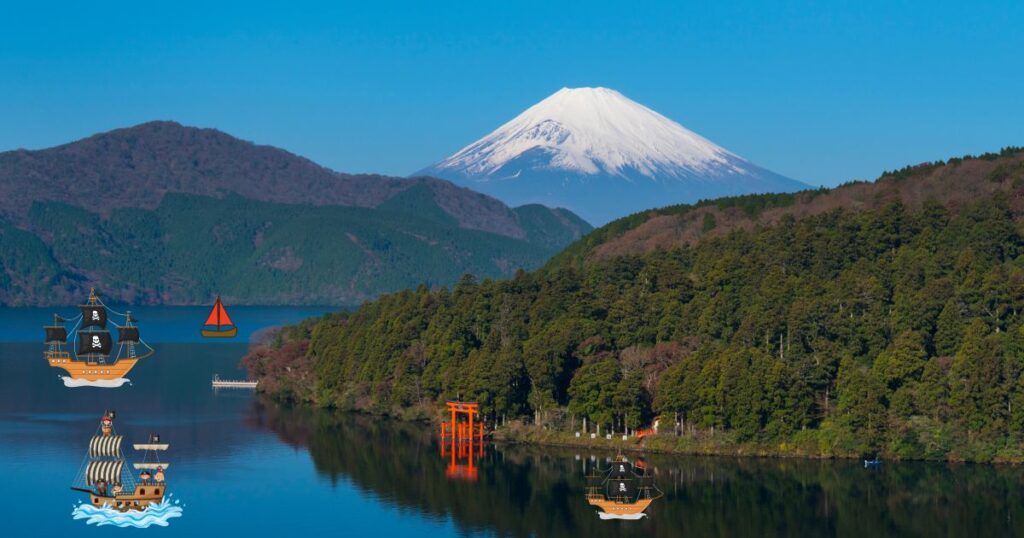Hakone, a charming town in the mountainous region of Kanagawa Prefecture in Japan, is a sublime blend of scenic beauty, rich history, and cultural depth. Hakone offers an immersive escape from the hustle of city life, known for its hot springs, the iconic Lake Ashi, and views of the illustrious Mt. Fuji. From the tranquil rides on the Hakone Tozan Railway and the Ropeway, through the vibrant art scene, to the serene onsen baths in traditional ryokans, Hakone promises unforgettable experiences that speak to the soul of every traveler. That’s why thousands of nature-loving people visit Hakone from Tokyo daily and return in the evening.
Table of Contents
1)Geographical location:
Kanagawa, neighboring Tokyo, is one of Japan’s 47 prefectures. It’s known for attractions like Kamakura, Yokohama, Hakone, Shonan Beach, and Enoshima. Hakone, a popular tourist destination, is easily accessible from both Tokyo and Kanagawa. It’s common for both local and international tourists to take day trips from Tokyo.
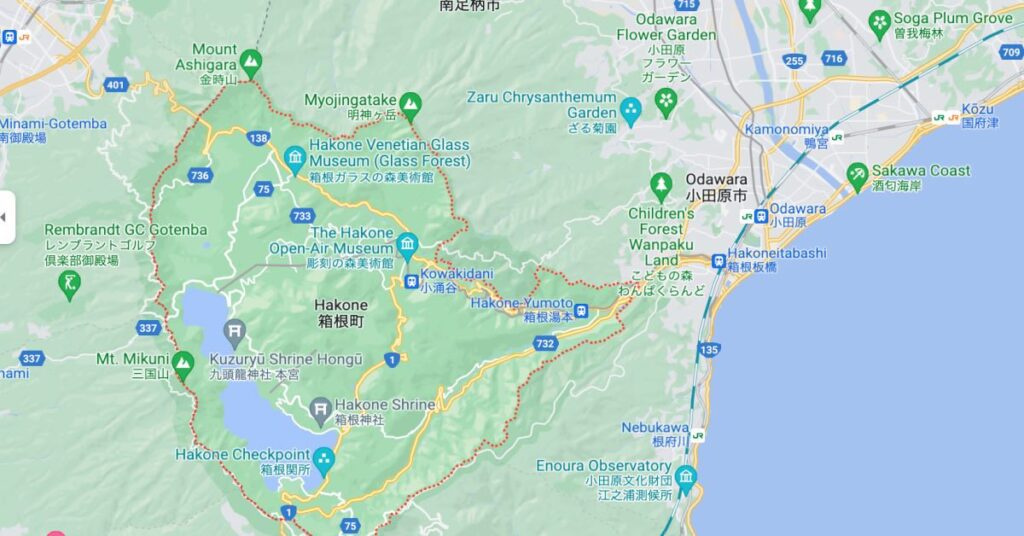
You can Zoom Google Maps here.
2)What’s the best season to visit Hakone?
Hakone is beautiful year-round, but the best seasons to visit are:
- Spring (March-May): During this time, cherry blossoms bloom, creating stunning scenery.
- Autumn (October-November): The fall foliage in Hakone is breathtaking, with vibrant red, orange, and yellow leaves.
- Summer (June-August): Although it can be humid, Hakone provides a cooler escape from Tokyo’s summer heat. It’s also the time for many local festivals.
- Winter (December-February): Less crowded, Hakone offers stunning views of Mt. Fuji against clear, blue winter skies. Hot spring (Onsen) visits are particularly enjoyable in the cold season.
Choose based on your preference for weather and scenery. Each season offers unique experiences.
3)What to see there?
Hakone is packed with a variety of attractions:
1)Hakone Shrine:
A serene Shinto shrine nestled in the woods, famous for its large torii gate on Lake Ashi.
Nestled within the verdant tranquility of a sacred forest, Hakone Shrine is a hidden gem in Japan’s enchanting landscape. It is a serene Shinto shrine, rich with history, and gives visitors peace and spirituality. The soft whispers of the rustling leaves, coupled with the mystic aura of the place, create an atmosphere of profound tranquility.
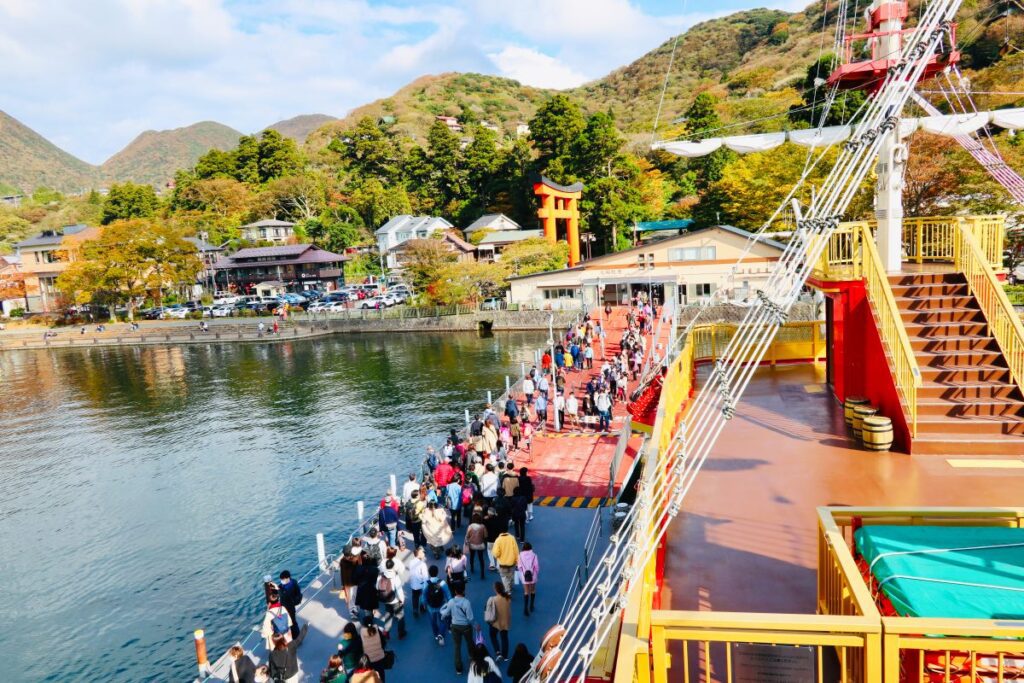
The most iconic aspect of the Hakone Shrine is its colossal torii gate, standing majestically on the edge of Lake Ashi. This grand red gate, partially submerged in the lake, creates a surreal picture against the stunning backdrop of azure waters and lush green hills. As the sun sets and the Torii gate casts its reflection on the calm lake, the sight is nothing short of spectacular.
Visiting Hakone Shrine offers a unique opportunity to delve into Japanese culture and spirituality. The shrine’s striking Torii gate and idyllic setting are a harmonious blend of natural beauty and spiritual significance. A journey to this ethereal place is akin to stepping into a realm where nature and spirituality intertwine seamlessly, making it a truly unforgettable experience.
2)Choanji Buddhist Temple:
Choanji is one of the old temples of Zen Buddhism in Hakone.
Nestled amid Hakone’s serene landscape, Choanji Buddhist Temple is a venerable sanctuary of Zen Buddhism, a silent testament to centuries of spiritual heritage. Its rustic charm is enhanced by the tranquility of the surrounding area, offering an environment perfectly suited for meditation and contemplation. Amid the quiet rustling of leaves and the soothing sounds of nature, Choanji is a haven of peace and introspection.
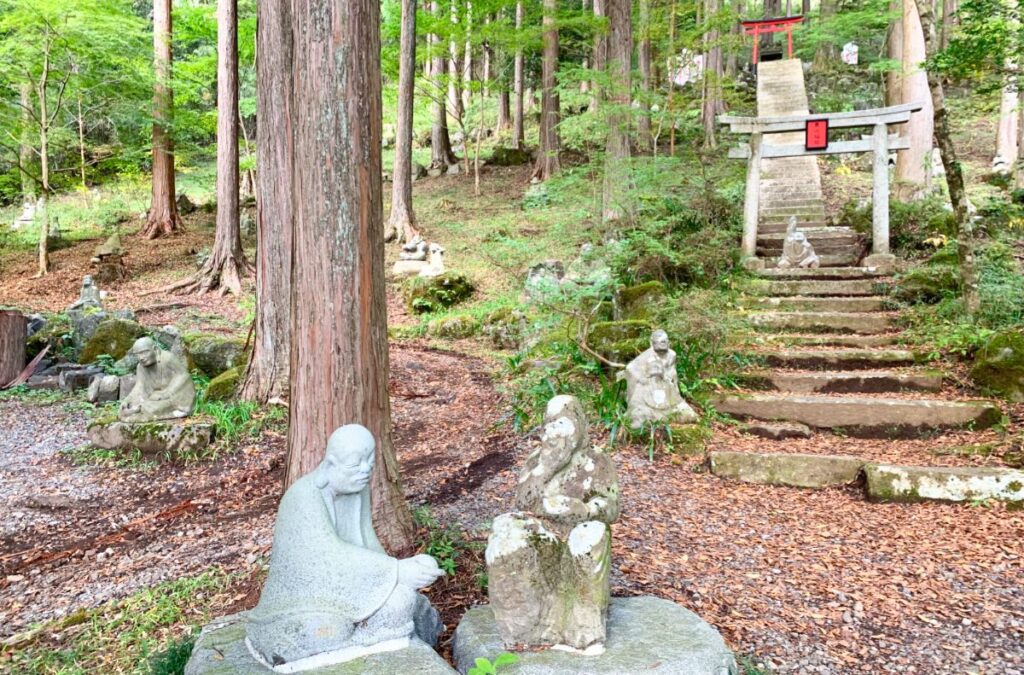
Choanji’s historical depth is not only mesmerizing but deeply profound. As one walks the temple grounds, they are stepping on the very stones that have borne witness to the ebb and flow of time and the evolution of Zen Buddhism. The temple’s timeless wisdom is encapsulated in its weathered walls, ancient statues, and air, each contributing to its unique spiritual ambiance.
The journey to Choanji is an immersion into the profound realm of Zen Buddhism, offering visitors a glimpse of Japan’s rich spiritual history. Each aspect of the temple, from its well-worn paths to the beautifully aged Buddha statues, is an invitation to pause, reflect, and connect with the essence of Zen teachings. A visit to Choanji is not just a trip to a historical site but an experiential journey into the heart of Zen Buddhism.
3)Lake Ashi (Ashinoko):
You can cruise on this beautiful lake, often with views of Mt. Fuji. Many tourists visit Hakone from Tokyo to see this wonderful lake every day.
Lake Ashi, locally known as Ashinoko, is a captivating natural spectacle in Hakone. This serene body of water, cradled within verdant hills, creates a picture of tranquility that invites visitors to pause and appreciate nature’s artistry. With the changing seasons, Lake Ashi transforms, offering diverse scenic vistas, each more breathtaking than the last.
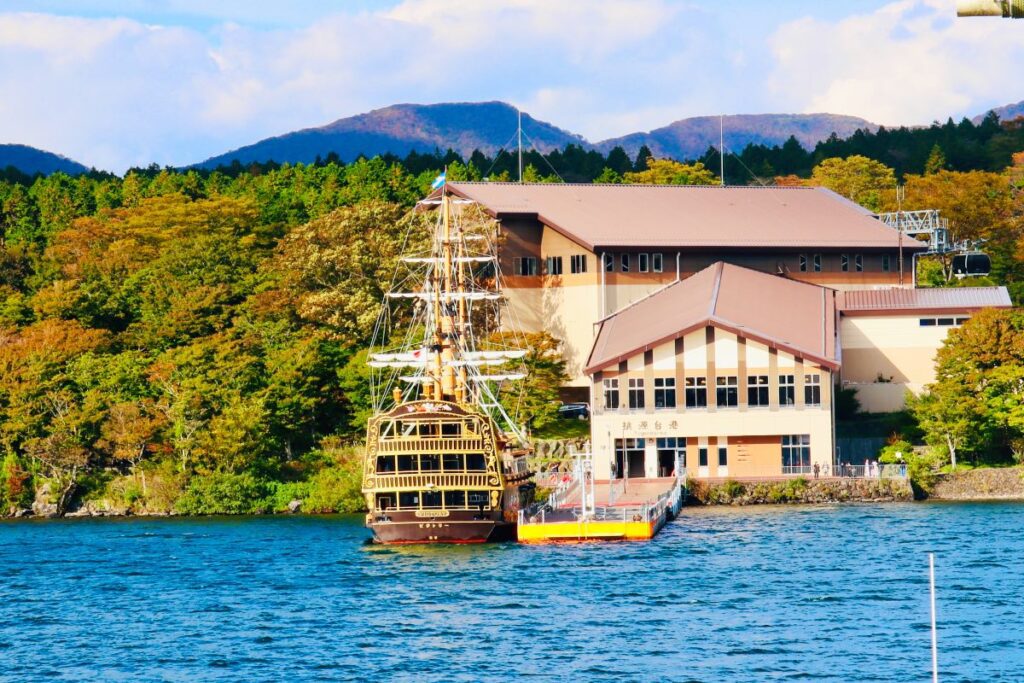
A key highlight of Lake Ashi is the opportunity to embark on an enchanting cruise. As the boat gently glides through the calm waters, visitors are treated to awe-inspiring panoramas unfolding all around. The sight of the iconic red torii gate of Hakone Shrine from the water is remarkable, but the true showstopper is the grandeur of Mt. Fuji, often visible in the distance. On clear days, the reflection of this majestic peak on the lake’s mirror-like surface is mesmerizing.
Exploring Lake Ashi is an experience that soothes the soul and uplifts the spirit. The tranquility of the water, the lush surrounding hills, and the stunning views of Mt. Fuji combine to create an atmosphere of serene beauty. A cruise on Lake Ashi is not merely a journey across the water; it’s a voyage into a picturesque world where nature’s splendor unravels at every turn.
4)Owakudani Valley:
Owakudani Valley, in the heart of Hakone, is an awe-inspiring manifestation of our planet’s volcanic activity. The valley teems with active sulfur vents, steaming hot springs, and a unique moonscape terrain that lends an otherworldly allure. As visitors wander through this intriguing landscape, they are reminded of the elements shaping our world and the vigorous geothermal activity beneath the surface.
Perhaps the most fascinating attraction in Owakudani Valley is the famous black eggs or “Kuro-tamago.” These are regular eggs, but their shells turn black due to being boiled in the valley’s sulfuric hot springs. Consuming these eggs is not only a culinary adventure but also a cultural experience, as local folklore believes eating one can add seven years to your life.
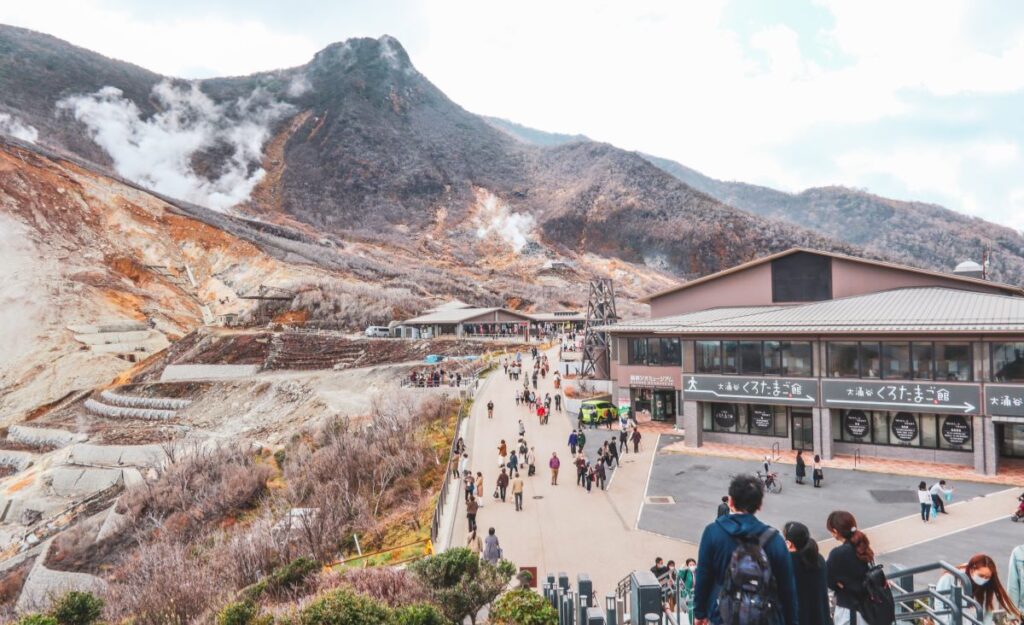
A visit to Owakudani Valley is a journey into an environment shaped by nature’s raw power. The sight of billowing steam, the smell of sulfur in the air, and the taste of the iconic black eggs make for a multisensory exploration. This distinctive valley, with its geothermal wonders and cultural nuances, offers a glimpse into the dynamic, ever-changing nature of our Earth.
5)Hakone Open-Air Museum:
The Hakone Open-Air Museum is a creative oasis nestled amidst the scenic beauty of Hakone. It ingeniously combines nature’s splendor with human artistic expression, offering a unique cultural experience. The museum’s sprawling green spaces are adorned with an eclectic mix of sculptures and art installations, creating a diverse visual feast that leaves visitors in awe.
Each turn in the museum’s winding pathways introduces a new spectacle of creativity. Modern and abstract sculptures stand alongside intricate art installations, each piece harmoniously blending with the landscape. The dynamic interaction between the art, the sky, and the verdant surroundings adds an extra dimension to each exhibit, creating an ever-evolving tableau that changes with the seasons and the time of day.
Visiting the Hakone Open-Air Museum is a journey through a labyrinth of artistic imagination. It offers an unparalleled opportunity to appreciate art in an immersive outdoor setting. Under the open sky and amid the lush greenery of Hakone, this museum provides a creative sanctuary that stimulates the senses and enriches the spirit.
6)Hakone Ropeway:
On clear days, it offers stunning panoramic views of Hakone, including Lake Ashi, Owakudani, and potentially Mt. Fuji.
The Hakone Ropeway, a feat of engineering that sails gracefully through Japan’s heavenly landscapes, offers an experience unparalleled in its visual majesty. As you ascend from the earthly terrain, you are gradually enveloped in a breathtaking panorama that feels like a beautiful painting coming alive.
Lake Ashi, a mirror-like body of water, reflects the serene beauty of the sky, and the volcanic valley of Owakudani, with its hot springs and active sulfur vents, presents an astonishing glimpse into the volatile heart of the earth.
On good clear days, the pièce de resistance of this awe-inspiring journey is the majestic view of Mt. Fuji. A sight that arrests your senses, the silhouette of this iconic stratovolcano etches itself against the sky, a vision that whispers tales of tradition and reverence. Its snow-capped peak, so picturesque, it feels almost surreal, radiates an otherworldly serenity, becoming the showstopper in this grand spectacle of nature.
Whether it is the tranquil charm of Lake Ashi, the geological wonders of Owakudani, or the enigmatic aura of Mt. Fuji, each facet of the journey on the Hakone Ropeway takes you through a splendid symphony of nature’s marvels.
7) Pola Museum of Art:
An art museum featuring works from prominent Western and Japanese artists set in the forest.
Tucked away amidst the verdant embrace of the Hakone forest, the Pola Museum of Art harmoniously merges the grace of nature with the power of human creativity. As a sanctum of artistic brilliance, the museum houses an enviable collection of prominent Western and Japanese artists, offering a cultural dialogue that spans across geographies and periods. The museum itself is a testament to architectural brilliance, it’s translucent facade and thoughtful design blending effortlessly with the lush surroundings, creating a space that bridges the divide between the organic and the man-made.
Once you enter the museum, you’re transported into a world where creativity reigns supreme. Under the watchful gaze of luminaries such as Picasso, Renoir, and Monet, alongside their Japanese contemporaries like Yokoyama Taikan and Hishida Shunso, you embark on an intellectual journey that transcends borders. Each piece of artwork, curated meticulously, acts as a window into the artists’ worldviews, offering a unique vantage point to understand diverse cultures, histories, and philosophies.
Yet, what sets the Pola Museum of Art apart is its sublime ability to engage with the natural beauty that encircles it. The verdant forest becomes an extension of the exhibition, with curated views from the museum’s windows turning nature into a living canvas of ever-changing art. The intimate communion between art and nature here adds a layer of tranquility and depth to the museum experience, creating a tranquil oasis where the magic of human creativity and the majesty of the natural world coexist in perfect harmony.
8) Hakone Tozan Railway:
Tozan mountain railway offers scenic views, especially beautiful during the autumn foliage and spring cherry blossoms. Many tourists access Hakone from Tokyo using this line.
The Hakone Tozan Railway, a transportation marvel nestled in Japan’s heart, delivers a captivating journey through nature’s vibrant canvas. This mountain railway, with its winding tracks and scenic routes, presents an unparalleled experience that is made even more spectacular by the seasonal transitions of its surroundings.
Whether it is the riotous palette of autumn foliage or the ethereal grace of spring cherry blossoms, each journey on this railway offers an evolving tableau of enchanting landscapes.
During autumn, the ride turns into a dreamy passage through corridors of trees set aflame with fall colors, a spectacle of nature’s own making. The stunning red, orange, and yellow hues dance in harmony, casting a magical glow over the journey. As the train chugs along, you’re made privy to a temporary art show where the verdant landscape transforms into a mosaic of autumnal brilliance.
In the heart of spring, the railway becomes a portal to a pink-hued paradise, with the blooming cherry blossoms blanketing the landscape. Their delicate beauty, ephemeral yet poignant, creates a dreamscape that seems to have leaped out of a painting.
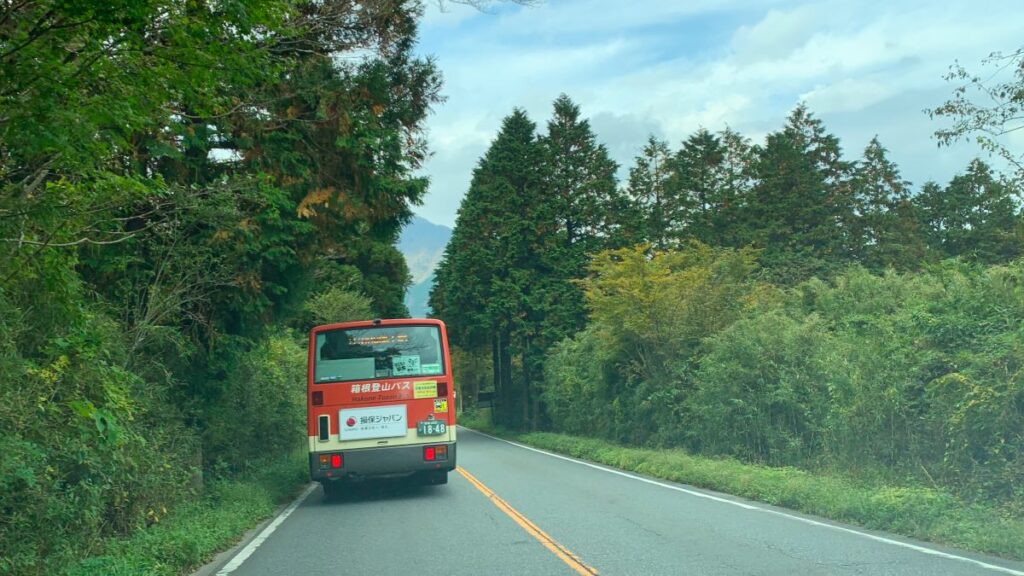
As the petals flutter in the breeze and cascade down, they transform the railway journey into a breathtaking hanami (flower-viewing) experience, imbuing the ride with an ethereal sense of wonder and tranquility. The Hakone Tozan Railway is not just a transport service but a celebration of nature’s dynamic splendor and a testament to Japan’s enduring love affair with the changing seasons.
9) Onsen (Hot Springs):
With its vibrant landscapes and cultural richness, Hakone is a treasure trove for explorers, yet one of its most enchanting offerings lies beneath the earth’s surface: its famous Onsen, or hot springs. Renowned for their healing properties and profound tranquility, these thermal waters are integral to Hakone’s identity.
Whether it’s a secluded spring hidden in the heart of the woods or a ryokan’s open-air bath with vistas of the surrounding mountains, each onsen experience is a unique journey into relaxation and rejuvenation.
The traditional inns, or ryokans, scattered across Hakone offer a window into an authentic onsen experience. As you immerse yourself in the calming, mineral-rich waters of the hot springs, the world outside fades into oblivion. Each soak is a ritual, a hallowed practice of introspection and relaxation, offering a respite from the relentless pace of modern life. Accompanied by the ryokan’s warm hospitality and traditional aesthetic, the onsen experience becomes a spiritual vacation into the heart of Japanese culture.
Planning your Hakone itinerary can seem overwhelming, given the area’s vastness and attractions. It’s worth noting that Hakone is not just about ticking off tourist spots; it’s about immersing in its soul-soothing ambiance.
Be it a leisurely stroll through the leafy trails, a ride on the scenic mountain railway, an afternoon spent admiring art, or the sublime pleasure of a tranquil soak in an onsen, Hakone invites you to explore at your own pace. Remember, your Hakone journey is about personal interests and indulgences; let them guide you through this captivating Japanese gem.
10) Silver Grass Field:
Situated in the scenic realm of Sengokuhara, Kanagawa, the Silver Grass Field or the Sengokukogen Pampas Grass Fields, as they are locally known, paint an ethereal landscape reminiscent of a dream.
These expansive fields, nestled at the base of Mt. Daigatake, stretch as far as the eye can see, their silvery sheen glistening under the sunlight, creating a mesmerizing spectacle. The rustling of the slender stalks in the breeze seems to whisper tales of the land, adding a mystical layer to the charm of the area.
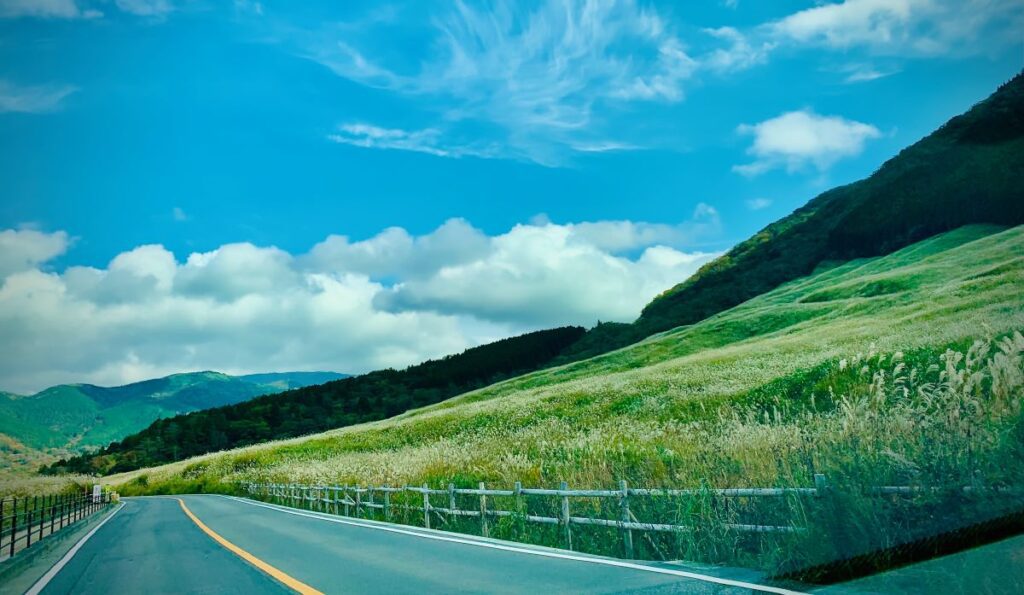
As you approach these fields, what strikes you first is their magnificent scale and the shimmering hues of silver and gold that define them. It’s an all-encompassing panorama that seizes your senses, leaving you stunned at the beauty nature has to offer.
The sight of the silver grass swaying gently against the backdrop of the formidable Mt. Daigatake, contrasting its robust ruggedness, is a sight to behold, a testament to nature’s diverse canvas.
The Silver Grass Field is a natural wonder and a poetic representation of the Japanese appreciation for transient beauty. As seasons change, the fields transform, mirroring life’s ephemeral yet profound charm. Be it the sun’s rays bouncing off the fields in the morning or the captivating play of shadows in the late afternoon, every moment spent here unveils a different facet of its enchanting beauty. The Silver Grass Field is indeed a gem of Sengokuhara, a marvel that allows you to connect with nature in its purest form.
4)Where to eat?
Lake Ashi, in Hakone, is a must-visit for every traveler to the region. Famous for its crystal-clear water and stunning vistas, it offers a perfect spot for visitors to relax and soak in the natural beauty. Sitting by the lake, feeling the cool breeze, and taking in the tranquil surroundings is an experience many cherish.
The lake area also boasts a variety of restaurants and shops. Tourists can savor a hot cup of coffee or delicious meals, all the while enjoying the captivating view of Lake Ashi. Moreover, the lake is more than just a spectacle; it is a source of fresh fish that often find their way into the local cuisine.
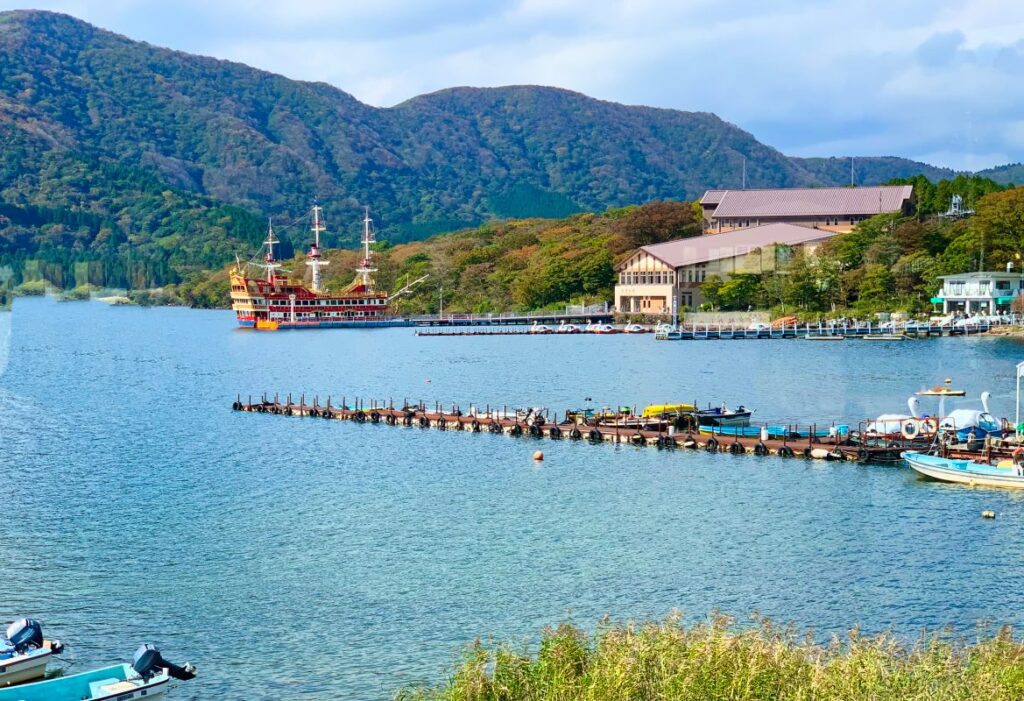
Among the lakeside dining options, one standout is ‘Restaurant Ueno.’ Not only do they serve mouthwatering dishes, but they specialize in serving fresh fish caught from Lake Ashi itself. The restaurant’s owner is known to catch fish daily, ensuring the utmost freshness and quality. And the best part? These fish dishes are usually priced lower than other menu items. Make sure to ask the staff about the catch of the day.
The restaurant is on the second floor, providing an excellent vantage point for panoramic lake views. Its strategic location also lets you see Togendai Ropeway Station and the Pirate Stop. Undoubtedly, ‘Restaurant Ueno’ is a food lover’s paradise, offering an unbeatable combination of delectable food, fresh ingredients, and breathtaking views. It’s a dining experience that truly encapsulates the charm of Hakone.
5)How to access Hakone from Tokyo?
There are several ways to access Hakone from Tokyo, depending on your preferences and needs:
1) By Train:
Trains offer a fast and convenient option to reach Hakone from Tokyo.
a) Odakyu Line from Shinjuku:
You can take the “Romancecar” (Limited Express) service operated by Odakyu Railway from Shinjuku Station in Tokyo to Hakone-Yumoto Station. The journey takes approximately 85 minutes. Alternatively, you can take a slower regular train on the same line, which takes around two hours.
b) Tokaido Shinkansen (Bullet Train):
Another option is to take the Shinkansen from Tokyo Station or Shinagawa Station to Odawara Station. This trip usually lasts about 35-40 minutes. From Odawara, switch to the Hakone Tozan Line to reach Hakone-Yumoto Station, which takes about 15 additional minutes. Check Google Maps here.
Please note that if you plan to travel extensively around Japan, you might consider purchasing a Japan Rail Pass. This pass covers most Shinkansen lines and many other trains throughout the country. However, the Odakyu Line is not covered by the JR Pass.
2) By Bus:
Buses provide another option for travel from Tokyo to Hakone, although they might be less frequent than trains.
The Odakyu Hakone Highway Bus operates from the “Tokyo Station Yaesu Exit” to “Hakone Togendai,” located near Lake Ashi, a key attraction in Hakone. The journey takes approximately 2 hours and 15 minutes to 2 hours and 45 minutes, depending on traffic conditions. From Togendai, you can take a local bus or the Hakone Ropeway to visit other attractions in Hakone.
However, please remember that while the bus service is straightforward, it is subject to traffic conditions that can cause delays. The frequency of buses is also lesser than trains, so check the bus schedule in advance and allocate enough time for your journey.
3) By Car:
If you prefer driving, you can rent a car in Tokyo and drive to Hakone. The trip usually takes about 1.5-2 hours, depending on traffic. However, remember that non-resident drivers in Japan require an International Driving Permit. Also, Hakone’s roads can be narrow and winding, so prepare accordingly.
Regardless of your chosen mode of travel, Hakone’s mountainous scenery and onsen (hot springs) make it an excellent tourist destination for a day trip or overnight stay from Tokyo. If your primary departure point is Tokyo Station, taking the Shinkansen to Odawara Station and switching to the Hakone Tozan Line might be the most time-efficient option.
Helicopter:
There are helicopter services from Tokyo or Narita Airport to Hakone for a luxurious journey.
Each option has its benefits, depending on your preference and budget.
If you’re alone but want to visit Hakone, consider taking a One Day Bus Trip from Tokyo and come back in the evening. The company will guide you.
Check more about Hakone from Tokyo:
